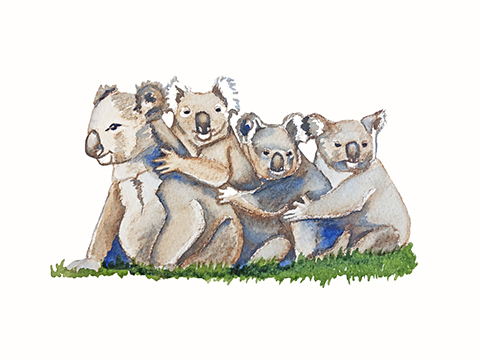A Torched Ecosystem
In the wake of fires that ravaged the continent, Australia’s wildlife is suffering the consequences.
April 15, 2020
There are images that come to mind when someone pictures Australia. One may think of tree branches holding koalas as they crunch blissfully on leaves, or a horizon dotted with the leaping silhouettes of kangaroos.
The region is known for its numerous native mammal species; however, the diverse animals are far from untouchable. There are countless threats to these creatures, with the continent holding a global record of 34 indigenous mammal species that have become extinct over the past 200 years.
The very existence of the animals is being threatened daily by poaching, deforestations and, most prevalently, dramatic changes in the continent’s climate.
According to Professor Chris Dickman at the University of Sydney, the adverse effects of climate change often reach Australia before the rest of the world.
Following the recent bush fire, it has become apparent just how much can go wrong when changes to the animal’s habitats make it so these creatures can’t survive.
“There’s so little research that’s been done, it stresses me out.”
With over 1.25 billion animal deaths in the area and 30 percent of koala habitats destroyed, places like New South Wales (NSW) have felt the drastic impacts that the fires have had on native species.
This accounts for about 80 percent of the total deaths in Australia, according to Professor Dickman’s estimate, which has doubtless risen since then. Many species are not included in these figures, namely bats, frogs and invertebrates.
The flames are not the only cause of peril and death. When they subside, they leave in their wake an environment almost as dangerous as when it was ablaze.
There are huge environmental challenges that arose post-blaze. After the fires, water supply remains scarce through the entire continent — not much is left to help replenish the land.
Predators, such as feral cats, were introduced into the spaces in burn areas. They threaten the remaining species there, especially when the animal populations are dropping.
A lack of shelter increases certain species’ vulnerability to predators. The mountain brushtail possums survived massive flames by hiding in tree hollows, but each fire increases the chance of these trees collapsing.
Also, displacement makes it hard for surviving species to find a living space in the sparse areas that were spared from the fires.
Recolonizing these habitats will take longer than ever due to the utter devastation of habitats and the resulting vast burn scars.
With temperatures of 40ºC last year, as well as high winds, fires were almost inevitable.
Although ecosystems in Australia have evolved to endure in the fire-prone environment, many are now in peril as the severity, frequency and duration of fires have increased drastically.
In the wake of these intense changing conditions, scientists are initiating efforts toward protecting the ecosystem from the fire-prone environment.
“There’s so little research that’s been done, it stresses me out,” said Anna Doty, a physiological ecologist at California State University who is investigating the fires’ and smoke’s effect on things like animals’ metabolism.
Dickman hopes the government will pay some attention to the science that will ultimately guide the nation toward the best recovery plan. “[Ecologists] have been frozen out of policymaking for over two decades,” he said.
When observing this issue from continents away, one must understand that devastating fires such as the recent one in Australia could be a problem that we could face as well.
Similar aspects between the Australia environment and the climate in southern-coastal California include hot, dry weather that makes it easy for flames to spark and spread and long periods of drought that turn our vegetation into kindling.
In other words, natural disasters could strike at any moment.
In preparation for our next Santa Barbara County fire, forestry management is the first thing that must be addressed, according to AP Environmental Science instructor Erik Faust.
It all comes down to the soil and plants and how they affect the rest of the ecosystem.
There is a quick response to put a stop to the fires that come through areas nearby Santa Barbara because they threaten the property and infrastructure of the city. By extinguishing these fires, the natural burn pattern of the fires, which would have otherwise gotten rid of some of the biomass, is “being prevented, which means you get a greater accumulation of biomass,” said Faust.
The accumulation of biomass is essentially fuel for fires.
If we stopped trying to put fires out immediately, they would be more frequent but less destructive.
“We’re trying to figure out what’s happening as things are changing,” Faust said, meaning that it’s harder to make accurate predictions.
Even with all these unknowns, it is imperative that we look at the patterns of wildfires, both in Australia and across the world, and do the best we can to prepare for the next natural disaster.
Hopefully, by being ready to face the flames, we will prevent lasting damage to the parts of our ecosystem that are most vulnerable.


































